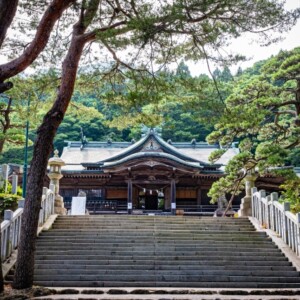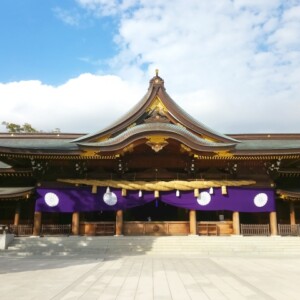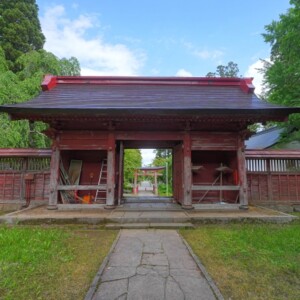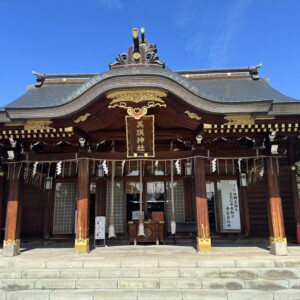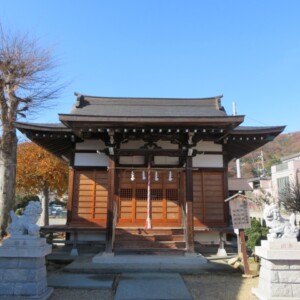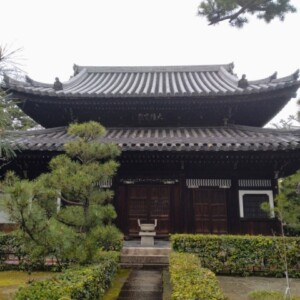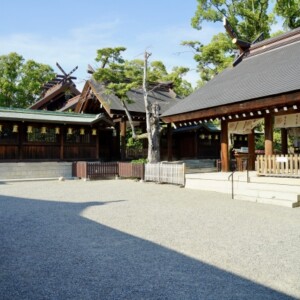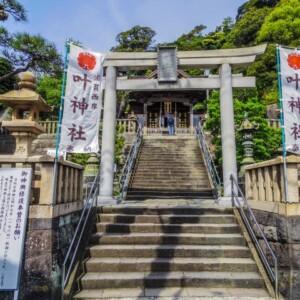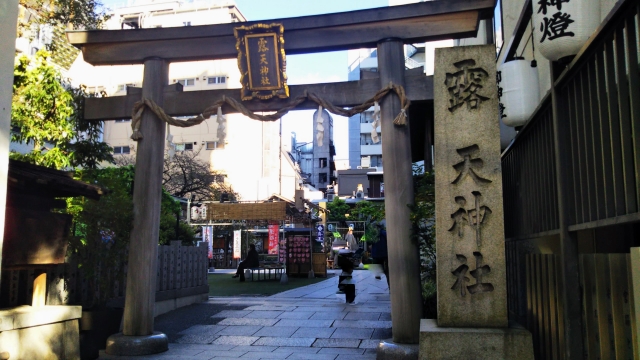
Open-air shrine (Ohatsu Tenjin)|Complete guide to the history, highlights, and worship information of this historic shrine
Nestled in a valley of buildings in Umeda, Osaka, Open Air Shrine is a sacred place for the fulfillment of love, known as the setting of Chikamatsu Monzaemon’s masterpiece “Sonezakishinju”. The shrine grounds, surrounded by tranquility amidst the bustling city, continue to be loved by many worshippers even today.
Outline and basic information about Open-Air Shrine (Ohatsu Tenjin)
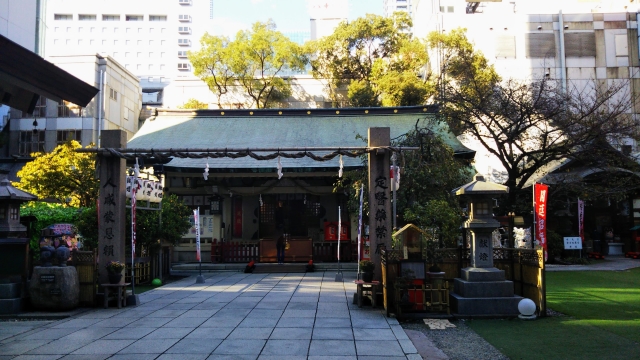
The open-air shrine is a historic shrine located in Sonezaki, Kita-ku, Osaka City. Although its official name is Tsuyu-no-Tenjinsha, it is popularly known as Ohatsu-Tenjin because of a tragic love story from the Edo period. Today, the shrine is the chief guardian of the Sonezaki and Umeda areas, and is worshipped by the local people.
History and Origin
According to shrine legend, this site was once an isolated island floating in Osaka Bay called Sonezaki-zu, where “Sumiyoshi Sumiji Sonejin” was enshrined. The shrine has an old history, with its construction dating back to around the first year of the Taiho Era (701), and it is considered one of the old sites of the “Namba Hakkushima Festival”.
The name of the shrine is said to have come about because water gushed out of a well in front of the shrine during the rainy season, and also because Michizane Sugawara, on his way to Dazaifu, recalled the capital here and shed tears while reciting a poem, “Dewdrops, tears, and my sleeves are rotting away, as I remember the capital. This is why the shrine is called “Dewen Shrine.
In 1703, Chikamatsu Monzaemon published a puppet play “Sonezakishinju” (Sonezaki Shinju), based on a heart attack that occurred on the shrine grounds, which became very popular, and the shrine came to be called “Ohatsu Tenjin” after the heroine of the play, named Ohatsu.
Gods of worship and benefits
The following deities are enshrined at the open-air shrine.
- Sunahikono-Ookami (Great Goddess of the Sun)
- Ohonamuchi no Okami
- Amaterasu no Mikami
- Toyokehime no Okami
- Michizane Sugawara
The shrine is especially known for its blessings for marriage and love, and also offers prayers for prosperous business, academic achievement, healing from illness, and traffic safety.
Highlights and Features of Open-Air Shrine (Ohatsu Tenjin)

Despite its location in the heart of Osaka’s bustling Kita district, the shrine is an urban oasis of calm and serenity.
Architectural and Structural Attractions
The current shrine pavilion was rebuilt in 1957, replacing the old one that was destroyed by fire during the Pacific War. The precincts of the shrine have four entrances on the east, west, south, and west sides, and the main gate is a magnificent structure with a wooden Myojin torii gate and a Shinto gate.
In front of the shrine pavilion, “Ukon no tachibana” and “Sakon no sakura” are planted in imitation of the Shicinden of the Kyoto Imperial Palace, and tachibana is considered a sacred tree for the prosperity of descendants and the safety of family members.
Cenotaph and monument for Oatsu and Tokubei
A bronze statue and a stone monument were erected in the precincts of the temple to commemorate the two who lost their lives in a tragic love affair during the Sonezakishinju (Sonezaki Love Suicide). The bronze statue was erected in April 2004, and has become a symbolic presence for those who wish for the fulfillment of love today, as well as a memorial to the two martyrs in love.
History of Sonezaki Shinju
In 1703, “Ohatsu,” a prostitute at Tenmaya in Dojima Shinchi, and “Tokubei,” the handmaiden of Hiranoya in Uchihonmachi, committed a suicide in Tenjin no Mori (behind the present-day shrine), an actual incident that became the setting for one of the most famous works in Japanese literary history. Chikamatsu Monzaemon published his work one month after the incident, and it struck a chord with the people of the time.
Visiting and Worship Information
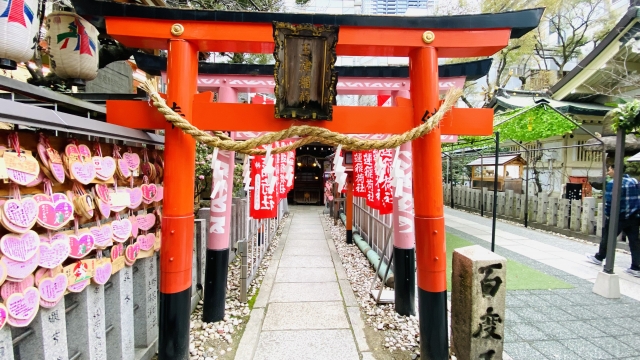
Open-air shrines welcome worshippers seeking a variety of blessings, especially for marriage. Although located in an urban area, this precious shrine is open for worship 24 hours a day, and even today is visited by many couples wishing for the fulfillment of their love lives.
Worship Etiquette and Manners
In accordance with basic shrine etiquette, bow when passing through the torii gate, and purify yourself at the hand-watering basin before going to the hall of worship. Pray for the fulfillment of your love and other wishes. There is also a golden plaque on the shrine grounds, which has been selected as a “holy place for lovers,” and is a popular place for couples and married couples to pledge their love to each other. As an urban shrine, it attracts many tourists, so be sure to visit the shrine quietly.
Annual and Seasonal Events
The annual festival is held on the third Saturday of July each year, and is a grand affair with a lively procession of yaku-daiko drums, dancing lions, and jiguruma musicians through the downtown area. The festival is filled with such enthusiasm that it is hard to believe that this is an urban area, and one can feel the unity of the community.
On the first Friday of every month (except January), the Ohatsu Tenjin Flea Market is held, where about 30 to 40 unique antique dealers line the streets. The market offers a wide range of goods, from antiques to miscellaneous goods, and attracts many people as a famous event in the area.
Red Seal and Good Luck Charm Information
Osaka City’s open-air shrine, nicknamed Ohatsu Tenjin, offers a colorful selection of red seals. Since the shrine was the site of “Sonezakishinju,” the unique design of the red seal depicting Ohatsu and Tokubei has gained popularity.
The red seals are awarded for 500 yen for direct writing and 300 yen for sticker type. Red seals are also available for Suitengu Shrine, Konpira Shrine, and Tamatsu Inari Shrine, each of which has its own unique design. The red seal for Konpira-gu Shrine, in particular, is written on a gold-colored mount and has a luxurious design.
Many of the amulets are paired charms, especially those for marriage, and are highly recommended for couples visiting the shrine. There is a wide variety of charms available, including those for academic achievement and success in school, business prosperity, good luck in getting rid of bad luck, traffic safety, and safe childbirth and fertility.
Access and Information
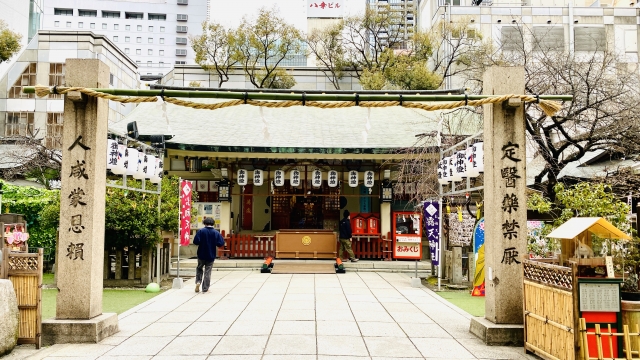
Open-air shrines boast excellent accessibility within walking distance of Osaka’s major stations, making them convenient for sightseeing and daily worship. Visitors can easily drop by the shrine in conjunction with shopping or dining in the Kita area of Osaka.
Transportation Access
The shrine is conveniently located a 5-minute walk from “Osaka Umeda Station” on the Hankyu Line and “Higashi Umeda Station” on the Osaka Metro Tanimachi Line. It is also a 5-10 minute walk from JR Osaka Station, Hanshin-Umeda Station, Nishi-Umeda Subway Station, Nishi-Umeda Station on the Yotsubashi Line, and Kitashinchi Station on the JR Tozai Line.
When you hit the “Ohatsu Tenjin Dori Shopping Street” in Umeda to the south, you will find the open-air shrine in the valley between the buildings. The route to the shrine is generally through the shopping street, where you can enjoy the bustling atmosphere of restaurants and stores while visiting the shrine.
Hours of worship, fees, and parking information
Visitors can visit the shrine from 6:00 a.m. to 24:00 midnight, and there is no admission fee. The shrine office is open from 9:00 a.m. to 6:00 p.m. for the acceptance of awards. Sticker-type red seals can also be conferred at other times.
Due to its urban location, there is no dedicated parking lot, but there are several coin-operated parking lots in the vicinity. We recommend that you visit the shrine by train, as access by public transportation is very convenient. It is common to visit the shrine in conjunction with shopping or dining in the Umeda area.
<Address> 2-5-4 Sonezaki, Kita-ku, Osaka 530-0057
Reference site
Official website of Open-air shrine: https://tuyutenjin.com/



